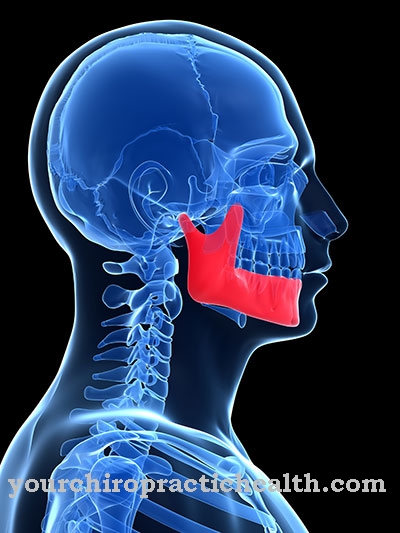Gallbladder cancer and Bile duct cancer (also medically: gallbladder carcinoma, bile duct carcinoma, cholangiocarcinoma) belong to the rarer types of cancer with a frequency of one percent of malignant tumors. It mainly affects patients over 60 years of age, more women than men.
What is gallbladder cancer?

© Henrie - stock.adobe.com
Gallbladder cancer develops out of the lining of the gallbladder, while bile duct cancer develops within the bile ducts in the liver due to cell changes. A special form of bile duct carcinoma is the Klatskin tumor, which spreads at the exit point of the intrahepatic bile ducts.
causes
The causes of gallbladder cancer and bile duct cancer are largely unknown. However, a connection with various pre-existing diseases of the liver and intestines has been observed.
The risk groups include Patients who suffer from gallstones, larger gallbladder polyps or chronic inflammation of the gallbladder that leads to calcifications within the gallbladder (porcelain gallbladder).
Liver parasites, salmonella diseases, which lead to permanent excretions, and chronic intestinal inflammation, ulcerative colitis, can increase the risk of gallbladder cancer or bile duct cancer.
Symptoms, ailments & signs
In the beginning, there are no symptoms with gallbladder cancer and bile duct cancer. That is why the disease is often discovered very late. In many cases the doctor only becomes aware of the tumor through the so-called Courvoisier's mark. The Courvoisier's symbol includes the two symptoms of jaundice and palpable enlargement of the gallbladder.
The jaundice is caused by biliary obstruction. The bile enters the blood. The elevated bilirubin levels cause painless jaundice with yellowing of the eyes and skin. The patient also suffers from excruciating and persistent itching. The urine also turns dark and the stool becomes discolored.
The stool appears whitish to gray. The enlarged gallbladder is also not painful, although the enlargement can be diagnosed not only by palpation but also by ultrasound. Other symptoms include increasing pain in the upper right abdomen, nausea and vomiting. The patient also suffers from poor appetite and severe weight loss.
If the disease is only diagnosed after the first symptoms have appeared, the chances of recovery are usually very poor because metastases have already formed. The so-called Klatskin tumor, however, has a better chance of recovery. This type of bile duct tumor creates a bile congestion early on. Therefore, jaundice occurs at a stage in which the tumor can still be completely removed.
Diagnosis & course
The diagnosis of biliary tract cancer and gallbladder cancer is made through a physical exam and a detailed medical history. If the tumor is already very advanced, a pressure-insensitive resistance can be felt in the upper abdomen, which is medically referred to as the “Courvoisier's sign”.
Elevated bilirubin values and other elevated liver values can be detected in the blood. Imaging methods such as sonography, CT, MRT or endoscopic examinations are used for the final diagnosis. The diagnosis is often incidental during an operation in the upper abdomen or a gallbladder resection.
The 5-year survival rate is less than 20 percent due to the increased late detection. Only in the case of very small carcinomas and the slowly growing Klatskin tumor are the chances of recovery considered more favorable.
Complications
Gallbladder cancer and bile duct cancer cause the usual symptoms and complications of cancer. A tumor cannot be completely removed in every case. The later the diagnosis and treatment, the higher the risk of the tumor spreading to other regions. A positive course of the disease cannot be guaranteed and life expectancy may be reduced.
Gallbladder cancer and bile duct cancer generally make the patient tired and tired. As a rule, those affected no longer actively participate in life and also suffer from severe weight loss. In addition, jaundice and itching occur, which can develop in all regions of the skin. Not infrequently, the patients also suffer from abdominal pain, vomiting and nausea. The quality of life of the patient is considerably reduced and restricted by these tumors.
There are usually no complications with the treatment itself. The gallbladder cancer and bile duct cancer can be removed with the help of surgery or radiation therapy. However, complete removal is not always possible. If the tumor has already spread to other areas of the body, a complete cure is usually not possible.
When should you go to the doctor?
A doctor should be consulted as soon as there is a feeling of pressure in the right area of the upper body. If you experience pain or colic, you should see a doctor as soon as possible. If you feel sick, vomit, have a general weakness or have a fever, a doctor is needed. Symptoms such as diarrhea, constipation or a decrease in general performance should also be clarified. If the person concerned suffers from a vague feeling of illness, inner restlessness, insomnia or irritability, the symptoms should be discussed with a doctor.
Before taking any pain reliever medication, it is advisable to consult a doctor. Sudden attacks of pain are cause for concern. If these are particularly strong, an ambulance service should be informed. If you experience impairments in coping with everyday tasks or usual leisure activities, it is advisable to consult a doctor. Social withdrawal, increased need for sleep, exhaustion or indifference are also considered unusual.
If the state of health worsens because the symptoms increase in intensity or further symptoms occur, a check-up with a doctor is necessary. In the event of loss of appetite, noticeable changes in weight or fluctuations in mood, the information should be examined more closely by a doctor. In addition, discoloration of the skin or changes in the appearance of the skin indicate diseases that must be treated.
Doctors & therapists in your area
Treatment & Therapy
Gallbladder cancer and bile duct cancer are relatively difficult to treat due to their advanced development.
Surgical removal of the gallbladder, the extrahepatic bile duct and possibly part of the liver is therefore the most common method. A possible metastasis in the liver, duodenum and other organs can also be detected during the operation. Subsequent radiation therapy is rarely carried out because of the risk of damaging healthy neighboring organs. So far, there has been little success in chemotherapy. It is therefore mostly only used for pain relief.
The treatment therefore focuses on palliative therapies, which should enable the patient to continue to live as symptom-free as possible. Stents are used to widen the bile ducts so as not to obstruct the flow of bile and to avoid congestion in the liver. Medical research is still concerned with the therapy of so-called "afterloading". This is a special form of radioactive radiation that is carried out inside the body directly in the bile ducts.
Radioactive iridium is brought up to the tumor with a probe in order to stop the primary tumor growth in gallbladder cancer and bile duct cancer. If both therapies cannot be carried out due to anatomical conditions, it is possible to drain the bile juice with a catheter and collect it outside the body.
Outlook & forecast
The prognosis for gallbladder cancer and bile duct cancer depends on various influencing factors. It must always be provided according to the individual specifications and cannot be regarded as generally valid. Decisive for a cure are the progression of the disease, the spread of the tumor cells in the entire organism, the age of the patient and the general health of the person concerned.
The disease is more common in people over 60 years of age. Often there are already other diseases that weaken the organism as a whole. Since gallbladder cancer and bile duct cancer are usually difficult to treat due to their location, surgical intervention and subsequent cancer therapy are carried out. In comparison, removing the gallbladder is an easy procedure.
The difficulty, however, is to completely remove the entire diseased tissue. Cancer therapy prevents the cancer cells from forming again. At the same time, however, healthy cells that are essential for the healing process are also destroyed. There is also the difficulty that only a few methods of cancer therapy can be used here.
A full recovery is possible. It takes a few years because cancer therapy must be successfully completed for it. Since, in addition to possible other existing diseases, there can also be secondary diseases due to cancer and psychological disorders, an unfavorable prognosis is made in most cases.
prevention
A specific prevention of bile duct cancer or gallbladder cancer is not known. It is therefore important to pay attention to any symptoms that occur in good time and to get a medical examination. In patients who have suffered from gallstones frequently in the past or who are among the risk groups, regular liver tests are recommended, possibly in combination with sonographic examinations, in order to detect malignancies in the gallbladder or bile ducts in good time .
Aftercare
A treatment is followed by constant rehabilitation in a clinic. This should improve the quality of life and alleviate acute complaints. The unfavorable long-term prognosis for gallbladder cancer and bile duct cancer leads to regular check-ups. The anamnesis, sonography, survey of liver values and computed tomography have established themselves as recognized methods.
The last imaging procedure is necessary if a new disease is to be confirmed or excluded. In medical practice, control intervals have become established. Patients should present themselves quarterly in the first three years after an illness.The intervals are then extended to annual dates over six months.
The time of diagnosis also determines the intensity of follow-up care. Most gallbladder cancer and bile duct cancer can only be completely surgically removed in the early stages. Then complete healing is possible. No metastases have developed yet. Statistically speaking, only five percent of most patients live on after five years.
This aspect in particular brings an extraordinary burden for those affected and their environment. Psychological problems arise with a “life on demand”. This is why end-of-life care is a central instrument of aftercare, in which the sick can discuss existential questions.
You can do that yourself
Since the causes of both gallbladder cancer and bile duct cancer are still largely unexplained, according to the current state of science there is insufficient information for extensive self-help measures.
Often people only develop cancer in the second half of their life, so that especially people over 50 years of age belong to the risk group. In everyday life, it is increasingly recommended that these people maintain a healthy and conscious lifestyle as a precaution and even if they have an existing diagnosis. This includes a vitamin-rich and balanced diet. Excessive intake of fats, fiber or sugar should be avoided or reduced. The weight is to be kept in the normal range in order not to take additional risks of illness.
Sports activities and adequate exercise also strengthen the immune system. This leads to a reduction in the general susceptibility to illness. Stress, hectic rush and persistent emotional stress should be reduced. This may require changes in general lifestyle.
A positive attitude towards life, optimistic thinking and a stable social environment help to maintain health as well as a necessary recovery process. The sleeping conditions must also be checked and, if possible, optimized. In addition, the consumption of harmful substances and toxins should be avoided. In particular, you should refrain from consuming nicotine and alcohol.


.jpg)



.jpg)




















